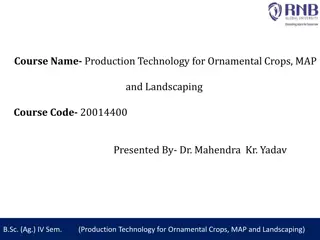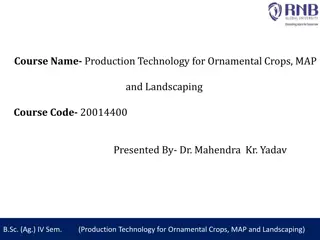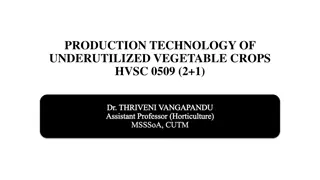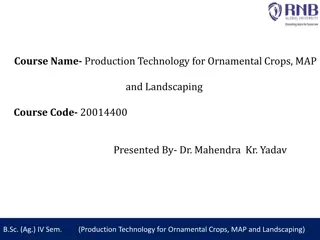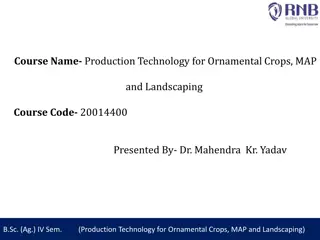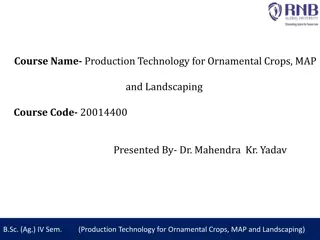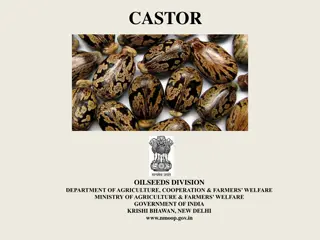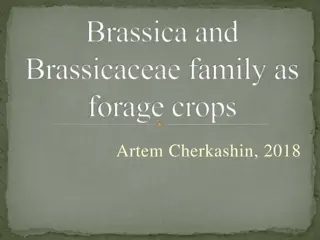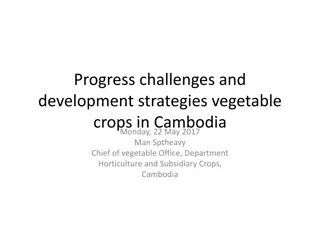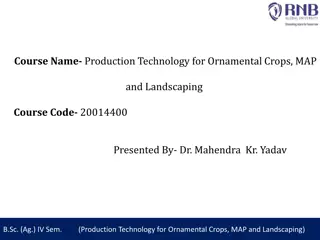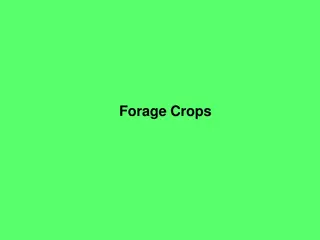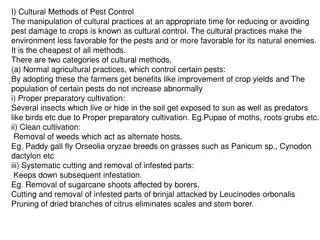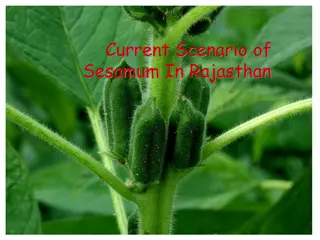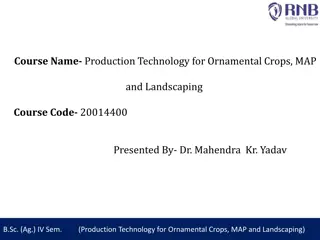Sustainable Cultivation Strategies for EU Crops
This project, funded by the Horizon 2020 Programme, aims to develop sustainable cultivation strategies for various crops in the European Union. Tasks include geographic allocation, trials, sowing strategies, irrigation/fertilisation trials, crop rotation, field tests, and scenarios for raw materials supply chains. The focus is on identifying suitable climatic zones for cultivation using GIS software and relevant databases. Climatic datasets such as daily precipitation and temperature, land use data, and land elevation models are utilized to assess crop suitability.
Download Presentation

Please find below an Image/Link to download the presentation.
The content on the website is provided AS IS for your information and personal use only. It may not be sold, licensed, or shared on other websites without obtaining consent from the author. Download presentation by click this link. If you encounter any issues during the download, it is possible that the publisher has removed the file from their server.
E N D
Presentation Transcript
WP3: Sustainable cultivation strategies Myrsini Christou CRES Funded by the Horizon 2020 Framework Programme of the European Union
Organisation Duration: Months: 1-54 Partners: CRES , DLO, LINNAEUS, UNIBO, UWM Work breakdown: Task 3.1: Geographic allocation of crops (M1-54) (CRES, DLO, UNIBO, UWM) Task 3.2: Screening trials (M1 M54) (UNIBO, DLO, CRES, UWM) Task 3.3: Sowing dates/strategies (M12 M48) (CRES, DLO, UNIBO, UWM) Task 3.4: Irrigation/fertilisation trials (M12 M54) (CRES, UWM) Task 3.5: Sustainable crop rotation strategies (M12 54) (UNIBO, CRES, UWM) Task 3.6: Large fields tests under real operational conditions (M25 M54) (UWM, CRES, UNIBO) Task 3.7: Scenarios for selected, industry-oriented, raw materials supply chains (M36 M54) (DLO, CRES, UNIBO, UWM) 2
Organisation Duration: Months: 1-54 Partners: CRES , DLO, LINNAEUS, UNIBO, UWM Work breakdown: Task 3.1: Geographic allocation of crops (M1-54) (CRES, DLO, UNIBO, UWM) Task 3.2: Screening trials (M1 M54) (UNIBO, DLO, CRES, UWM) Task 3.3: Sowing dates/strategies (M12 M48) (CRES, DLO, UNIBO, UWM) Task 3.4: Irrigation/fertilisation trials (M12 M54) (CRES, UWM) Task 3.5: Sustainable crop rotation strategies (M12 54) (UNIBO, CRES, UWM) Task 3.6: Large fields tests under real operational conditions (M25 M54) (UWM, CRES, UNIBO) Task 3.7: Scenarios for selected, industry-oriented, raw materials supply chains (M36 M54) (DLO, CRES, UNIBO, UWM) 3
Task 3.1: Geographic allocation of crops Duration: Months: 1-54 Partners: CRES , DLO, LINNAEUS, UNIBO, UWM The objective is to identify suitable climatic zones for the cultivation of the selected crops. The analysis of land availability will be based on spatial agro- climate data and performed in GIS software (global positioning system type). Databases like Corine Land Cover, Soil Geographical Database, etc. will be used in order to identify the land conditions 4
Datasets Climatic datasets are available for downloading at the website of the European Climate Assessment & Dataset project. After selection, the following data are included in the downloaded dataset Daily Precipitation Daily Temperature (Average , Minimum, Maximum) Land use and land cover data derived from EEA s database and Eurostat. EEA s Corine Land Cover programme provides dataset about land cover in Europe, classified in specific classes. The Eurostat s LUCAS (Land Use/Cover Area frame Statistical survey) dataset provides information about cover/land use and agro-environmental and soil data. Land elevation: ETOPO1 (Minute Gridded Global Relief Data) is a 1 arc-minute global relief model of Earth's surface developed by the National Geophysical Data Center of the National Oceanic and Atmospheric Administration (NOAA) in the US. In the further process only land topography data will be used. 5
Suitability of crambe for the several EU regions 6
Task 3.2 Screening trials Duration: M1 M54 Partners: UNIBO, DLO, CRES, UWM 10 entries of camelina and crambe presenting the most interesting agronomical traits coming from WP2 tests will be grown in all sites (Greece, Italy, Poland and Netherlands) for screening purposes. 10 entries of camelina were provided by Linnaeus and 10 entries of crambe by DLO Experimental design: randomised complete plot in 3 or 4 blocks Plot sizes: 9 m2 Seeding distances: Rows 0,15 m apart Reference oil crops like rapeseed or sunflower and cereals. 7
Experimental plots and blocks for crambe and camelina Crambe plots (9 m2) Crambe experimental field (640 m2) Block I 20m 4m 6m Block II Block III 1 2 3 4 5 6 7 8 9 10 11 12 13 14 15 16 17 18 19 20 21 4m 6m 1,5 m 32 m 0,15 m 1,5 m 8
Experimental plots and blocks for crambe and camelina Modified by: UNIBO Proposed by: WUR galactica galactica BL 1 galactica galactica BL2 screening crambe galactica galactica BL 3 galactica galactica BL 4 1.56 m 1.56 m Odd plots: Galactica 1.56 m 16 m 1.56 m 9 Even plots: New lines
Experimental plots and blocks for crambe and camelina Modified by: UNIBO Proposed by: WUR Galactica galactica galactica BL 1 galactica Galactica galactica Bl 2 screening crambe Galactica galactica galactica BL 3 Galactica galactica galactica BL 4 1.56 m 7,8 1,6 7,8 1.56 m Odd plots: Galactica 10 21 m Even plots: New lines
Sowing protocol for camelina: seeding date Seeding date: Spring or fall/winter Spring seeding: Prior to other spring-type Brassica crops. Seedlings not only frost tolerant but also tolerate several cycles of freeze thawing. If adverse weather prevents early spring seeding, camelina can also be seeded later (into mid-to late June) without a significant yield penalty due to its early maturity. Fall/winter seeding: Seeded in fall or on frozen ground from late October to early January (winter/dormant seeding), which makes it unique among spring-type oilseeds. Winter-sown camelina starts to germinate early in spring at temperatures around 1 C and emerges before any significant weed flushes: a feature that increases the competitiveness of the crop. Currently, it is debated whether spring or fall/winter seeding is superior. Source: Linnaeus 11
Sowing protocol for camelina: seeding rate Seeding rate: Optimum plant densities range from 114 to 172 plants/m2. Based on this, we recommend a seeding rate of 550 700 seeds/m2since this rate will provide targeted plant densities, even if only 25% of the seeds emerge. These rates correspond to 5.5 to 7.0 kg/ha. Higher plant stands can hasten the maturity of camelina plants by as much as 7 days. Because the size of camelina seeds is rather small (about 1/3 of canola seed, TKW: 1.0 1.2 gr), it is essential to seed at shallow depth (no deeper than 1.25 cm) and that there is adequate soil compaction and good seed-soil contact. Conventional drills and air drills work well for seeding; when seeding with an air drill, we recommend increasing the seeding rate to 7.0 kg/ha. Camelina can also be seeded by broadcasting with a Valmar, followed by heavy harrowing and rolling. It has also been successfully air-seeded on wet soils. Source: Linnaeus 12
Seeding rates for camelina plot length (m) plot width (m) seeded area (m2) Targeted seeds (/m2) TKW Germ Mort Seeding Rate no entry seed source (g) (%) (%) kg/ha g/plot g/row g/location g/trial 15CS0947 + 15CS0948 + 15CS0949 (mix of 13CS0787- 02, -03, -04) 3 3 3 3 3 3 3 3 3 3 3 3 9 9 9 9 9 9 500 500 500 500 500 500 1,31 0,95 0,05 1,36 0,95 0,05 1,93 0,95 0,05 10,72 1,77 0,95 0,05 1,29 0,95 0,05 1,41 0,95 0,05 7,28 7,56 6,55 6,80 9,65 8,85 6,45 7,05 0,27 0,28 0,40 0,37 0,27 0,29 26,20 27,20 38,60 35,40 25,80 28,20 104,80 108,80 154,40 141,60 103,20 112,80 1 14CS0886 15CS0950 2 13CS0787-05 15CS0951 3 13CS0787-06 9,83 7,17 7,83 15CS0953 4 14CS0787-08 15CS0954 5 13CS0787-09 15CS0960 15CS0964 + 15CS0965 + 15CS0966 (mix of 13CS0788- 01, -02, -03) 6 13CS0787-15 3 3 3 3 3 3 9 9 9 500 500 500 1,32 0,95 0,05 1,27 0,95 0,05 1,04 0,95 0,05 7,33 7,06 5,78 6,60 6,35 5,20 0,28 0,26 0,22 26,40 25,40 20,80 105,60 101,60 83,20 7 14CS0887 15CS0970 8 13CS0789-02 14CS0865 9 Midas 10 WUR TKW: Thousand Seed Weight Source: Linnaeus 13
Sowing protocol for camelina: inputs Choice of land: Because of the limited weed control options in camelina, only fields with known limited weed pressure should be chosen. The history of herbicide use on a particular field needs to be reviewed to avoid crop failure due to herbicide damage. Camelina is susceptible to residual SU and IMI herbicides. If it is not recommended to plant a Brassica crop such as canola or mustards the year after a certain herbicide has been applied, camelina should not be planted as well. Fertiliser requirements: The nutrient requirements of camelina have been shown to be similar to those of B. rapa. For maximum yield, about 90-112 kg/ha applied N is required and little less for lighter soils). The S and P requirements of camelina are not yet known; we therefore recommend amounts sufficient for canola production. Water requirements. Camelina s drought tolerance is a well-documented fact. Total evapotranspiration for camelina, which equals to the minimum water requirement of the crop, has been shown to be between 332 and 371 mm, which is significantly less than that of grain crops and canola (600-655 mm). Source: Linnaeus 14
Sowing protocol for camelina: inputs Weed control. Herbicide options in camelina are currently limited. The grassy herbicide Assure II has Minor Use Registration in camelina. In trials, good pre- emergence broadleaf weed control was achieved with Edge. We are currently working on Minor Use Registration. Once Edge is registered in camelina, it can be applied in the fall prior to dormant seeding or spring seeding or it can be applied in the spring prior to spring seeding. The use of Edge will offer farmers an option to rotate their chemicals. Post-emergence broadleaf herbicides will be available for use in camelina in the not too distant future. Pests and Diseases. One of the agronomic advantages of camelina is its resistance to flea beetles, blackleg and blackspot. Insecticide and fungicide treatment of the seed as well as lateseason insecticide sprays are not necessary. The only pathogen of potential economic importance in camelina is downy mildew, which mainly occurs under cool and moist weather conditions. Source: Linnaeus 15
Camelina harvest Pod shattering is not an issue in camelina; therefore, it can be directly combined. However, in fields with high weed pressure, we recommend to swath and combine. Swathing should be done when 75% of the crop has turned yellow. Direct combining can occur when seed moisture reaches 8% using a canola setting on your moisture tester. Conventional combines used to harvest other Brassica oilseeds can be used to harvest camelina. If possible, a small seed kit should be fitted in. Combine settings need to be adjusted to account for the small seed size. We recommend starting with the following settings, checking for seed loss, and then modifying accordingly: Ground speed: 4 5 MPH; Fan speed: 500 800 RPM; Cylinder speed: 800 1000 RPM; Concave space: 1 ; Top chaffer sieve number: 1/8 3/16 (JD, CASE IH, NH series). Holes in combines, grain trailers, and bins should be sealed to prevent the loss of seed. Camelina stems turn woody when they mature, similar to flax. However, camelina is easy to combine, the straw spreads nicely and degrades more readily than flax straw. It can be used as bedding material for cattle and horses. Source: Linnaeus 16
Sowing protocol for crambe: seeding date Seeding date: Sowing time depends on location and climatic conditions, bus as a general rule advanced sowing favors higher yields . In temperate climates it could be sown from September to November like rape whereas in colder climates it is advised to be sown as spring crop sown in late April or May. Under favourable conditions two crambe crops could be harvested in the same year, if the first crop is sown in early spring and the second about mid-July [Laghetti et al, 1995]. Source: Literature review 17
Sowing protocol for crambe: seeding rate Seeding rate: In literature, 75 -200 plants/m is advisable for high yields, corresponding to 15-20 kg of seeds/ha. Seeding rate of 17 kg/ha in rows 16 cm apart, if germination is 80-90%, thus giving about 126 plants /m2is recommended fro achieving satisfactory yields. Lower seeding rates resulted in lower plant densities but better yields due to increased plant branching and extended flowering period. Sowing could be done with mechanical broadcasting or in rows 15-35 cm apart in irrigated areas where weeds are not a problem and 45-60 cm apart in drier areas. In the large field of crambe in Poland, seeds at 15 kg/ha were sown by drill and the inter-rows were 12.5 cm. Planting depth is a critical factor in obtaining good crambe yields. Seed should be planted 0.6 cm deep in humid regions and up to 2.54 cm deep in drier areas. Source: Linnaeus 18
In spring 2013, a commercial field of crambe (Crambe abyssinica) was established in the north-east of Poland, at the Didactic and Research Station (53 35 N, 20 36 E), which is a unit of the University of Warmia and Mazury in Olsztyn in any The soil was prepared according to good agricultural practice. The following procedures conducted before sowing in the spring 2013: ploughing to a 20-cm depth, harrowing and cultivating (shortly before sowing). Crambe was sown on a total area of 10 ha. were 19
Sowing protocol for crambe: inputs Choice of land: as in camelina. Fertiliser requirements: Fertilizer requirements are similar to other spring oilseed crops; best results may be achieved with around 150 kg/ha applied to seedbeds (IENICA). Reports of fertilizer trials on Crambe are rare, other than to establish whether or not fertilizers are necessary, and application levels, types and timing must be locally determined. Crambe can be deep-rooted, and thus draw on soil nutrients at depth (Weiss, 1983). In the large field of crambe established in Poland, before the experiments were set up, phosphorus as triple superphosphate was applied at 40 kg P2O5/ha, potassium as potassium chloride at 60 kg K2O/ha and nitrogen as ammonium nitrate at 40 kg NH4NO3/ha. Subsequently, another dose of the same nitrogen fertiliser was applied as top dressing at 60 kg NH4NO3/ha. Source: Literature, UWM 20
Sowing protocol for crambe: inputs Weed control. Crambe has been found to be susceptible to Alternaria and sclerotinia and a well-timed fungicide application at the mid-flowering stage has had a yield response (up to 1t/ha) and may also improve oil content. Fungicide dressed seed may also beneficial. Some of the weeds that may cause difficulties are pigweed, foxtail, smartweed, lambsquarter, ragweed, and kochia. A uniform, thick stand of crambe is an effective means of weed control. Early planting also increases crambe's ability to compete with weeds, which require a higher soil temperature for germination. However, as crambe approaches maturity, weeds may emerge through the crop canopy, posing problems with harvest and increasing the moisture of harvested crambe seed. No herbicides have been registered for use on crambe in the U.S. Crambe is very susceptible to injury from 2,4-D drift and the residual effects of atrazine. In the large field of crambe in Poland spraying with glyphosate at 5 l/ha was applied before the crambe plantation was set up. Subsequently, immediately after sowing, the soil-applied herbicide Butisan Star 416 SC was applied at 2.7 l/ha. Source: Literature, UWM 21
Crambe harvest After flowering, crambe matures rapidly in one to two weeks. Timely harvest is important to avoid high shattering losses. During warm dry weather the crop should be frequently monitored (daily or every other day) to determine correct harvest stage. Crambe is physiologically mature when 50% of the seeds have turned brown. According to Weiss 1983 crambe is ready to be harvested when the majority of leaves have fallen, the upper part of the stem is yellow, and at least 75% of the capsules have turned yellow. This is usually some 90-100 days after planting. Extensive branching is considered to be a disadvantage for mechanical harvesting, and although branching may increase individual plant yield, it may also increase the number of harvested immature seeds. Crambe can be swathed to dry in the field, but most growers prefer to harvest Crambe direct with combine headers commonly used with wheat. Source: Literature 22
Crambe harvest In the large field of crambe in Poland, desiccation of the plants was performed before seeds of crambe were harvested with Klinik 360 SL at 4 l ha-1 to ensure uniform ripening of plants. The harvest was performed with a combine harvester in the fourth week of August 2013. The straw after harvest was left in the field to enrich soil with organic carbon. Source: UWM 23
Measurements Emergence date and rate Flowering date and rate Final height Number of branches/m2 Seed yields Oil profile Fresh and dry matter yields of field residues Moisture content of field residues at harvest. 24


